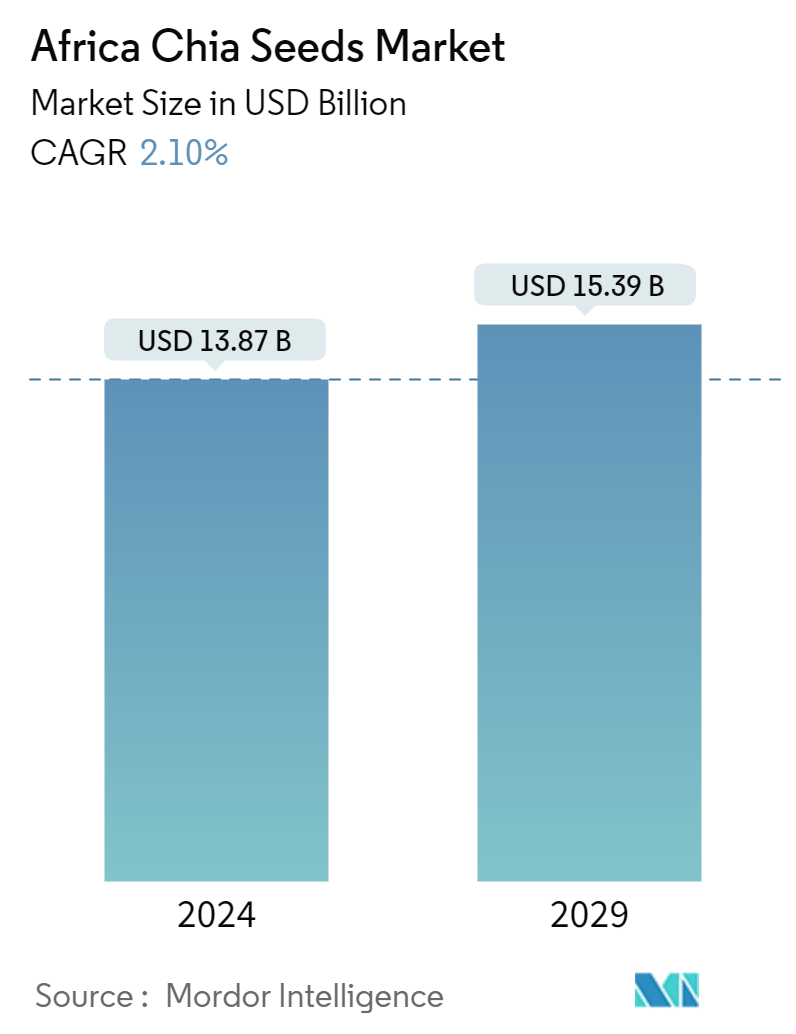Market Size of Africa Chia Seeds Industry

| Study Period | 2019 - 2029 |
| Base Year For Estimation | 2023 |
| Forecast Data Period | 2024 - 2029 |
| Market Size (2024) | USD 13.87 Billion |
| Market Size (2029) | USD 15.39 Billion |
| CAGR (2024 - 2029) | 2.10 % |
Africa Chia Seeds Market Analysis
The Africa Chia Seeds Market size is estimated at USD 13.87 billion in 2024, and is expected to reach USD 15.39 billion by 2029, at a CAGR of 2.10% during the forecast period (2024-2029).
Chia seeds thrive in African nations like Uganda, Ethiopia, Kenya, and Tanzania, thanks to their favorable climatic conditions. As global demand for chia seeds surges, farmers in these regions, alongside a growing number of exporters, have adeptly maintained production levels. For example, in August 2023, Talia Group, an export company, highlighted its need for 18,000 farmers in Northern Uganda to cultivate chia, aiming for a target of 5,000 metric tons, underscoring the market's escalating demand.
Chia seed production in these African nations is predominantly export-driven. This is largely due to limited domestic consumption, stemming from a general lack of awareness about the seeds' benefits among local consumers. For instance, Chia Organic pioneered the mass cultivation of chia seeds in Uganda. Their internationally sought-after product now faces a staggering demand, with the company meeting only 30% of it. This reflects the export demand for the chia seeds grown in Africa.
Yet, South Africa is witnessing a burgeoning interest in chia seeds, celebrated for their protein content and unsaturated fatty acids. Retailers in many South African supermarkets and hypermarkets are increasingly stocking various brands of chia seeds to cater to this rising local demand. In Africa, chia seeds predominantly find their way to consumers through retail channels, with many incorporating them into their daily diets.
Africa Chia Seeds Industry Segmentation
Chia seeds are derived from the desert plant Salvia hispanica, a member of the mint family. Salvia hispanica seed is often sold under its common name 'chia'. The report defines the chia seed as a commodity, and the market sizing is done at the wholesale level. To eliminate any 'double-count' error in the market estimations, bulk buyers that procure chia seed products for sale after value-addition through further processing are not considered a part of the chia seed market. The African chia seed market includes production analysis (volume), consumption analysis (value and volume), export analysis (value and volume), import analysis (value and volume), and price trend analysis of chia seeds across the region. The market is also segmented on the basis of geography (Uganda, Kenya, South Africa, Tanzania, and the Rest of Africa). The report offers the market size and forecasts in terms of value (USD) and volume (metric tons) for all the above segments.
| Geography (Production Analysis by Volume, Consumption Analysis by Volume and Value, Import Analysis by Volume and Value, Export Analysis by Volume and Value, and Price Trend Analysis) | |
| Uganda | |
| Kenya | |
| South Africa | |
| Tanzania | |
| Rest of South Africa |
Africa Chia Seeds Market Size Summary
The Africa Chia Seeds Market is poised for growth, driven by the increasing global demand for chia seeds as a functional food. Despite challenges such as the COVID-19 pandemic, Africa has emerged as a significant player in chia seed production, with a focus on export-oriented activities. The region's farmers have successfully maintained production levels, supported by a growing network of local and regional markets. Chia seeds, known for their gluten-free and high protein content, are gaining popularity, particularly among consumers with gluten intolerance and those seeking healthier lifestyle choices. The rising awareness and demand for ancient nutritional grains and multi-cereal-based products further bolster the market's expansion.
In South Africa, the demand for chia seeds is particularly strong, with retailers stocking various brands to cater to local consumers. The seeds are increasingly recognized for their health benefits, including being a source of omega-3 fatty acids, making them an attractive option for health-conscious individuals and those preferring vegetarian diets. The market is also seeing a rise in innovative chia-based products that are allergen-friendly and high in fiber, aligning with the growing trend towards protein-based vegan foods. Uganda plays a crucial role in chia production, with efforts from NGOs and private businesses supporting farmers in cultivating this less labor-intensive crop. Despite challenges in organizing supply for international markets, the fertile soil and organic farming practices in Uganda contribute to the clean production of chia seeds, with companies like Ubelhor and Davert leading the way in organic chia cultivation and export.
Africa Chia Seeds Market Size - Table of Contents
-
1. MARKET DYNAMICS
-
1.1 Market Overview
-
1.2 Market Drivers
-
1.2.1 Increasing Demand for Protein-based Vegan Food
-
1.2.2 Growing Exports of Chia Seeds
-
1.2.3 Government Support
-
-
1.3 Market Restraints
-
1.3.1 Limited Awareness about Chia Seeds
-
1.3.2 Lack of Production of Chia Seeds in the Country
-
-
1.4 Value Chain Analysis
-
-
2. MARKET SEGMENTATION
-
2.1 Geography (Production Analysis by Volume, Consumption Analysis by Volume and Value, Import Analysis by Volume and Value, Export Analysis by Volume and Value, and Price Trend Analysis)
-
2.1.1 Uganda
-
2.1.2 Kenya
-
2.1.3 South Africa
-
2.1.4 Tanzania
-
2.1.5 Rest of South Africa
-
-
Africa Chia Seeds Market Size FAQs
How big is the Africa Chia Seeds Market?
The Africa Chia Seeds Market size is expected to reach USD 13.87 billion in 2024 and grow at a CAGR of 2.10% to reach USD 15.39 billion by 2029.
What is the current Africa Chia Seeds Market size?
In 2024, the Africa Chia Seeds Market size is expected to reach USD 13.87 billion.

